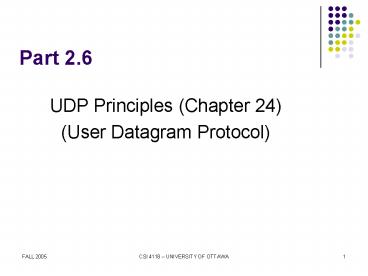UDP Principles (Chapter 24) PowerPoint PPT Presentation
Title: UDP Principles (Chapter 24)
1
Part 2.6
- UDP Principles (Chapter 24)
- (User Datagram Protocol)
2
UDP User Datagram Protocol
- In TCP/IP protocol suite, using IP to transport
datagram (similar to IP datagram). - Allows a application to send datagram to other
application on the remote machine. - Delivery and duplicate detection are not
guaranteed. - Low overhead faster than TCP
3
UDP Characteristics
- End-to-End an application sends/receives data
to/from another application. - Connectionless Application does not need to
preestablish communication before sending data
application does not need to terminate
communication when finished. - Message-oriented application sends/receives
individual messages (UDP datagram), not packets. - Best-effort same best-effort delivery semantics
as IP. I.e. message can be lost, duplicated, and
corrupted. - Arbitrary interaction application communicates
with many or one other applications. - Operating system independent identifying
application does not depend on O/S.
4
Identifying An Application
- UDP cannot extend IP address
- No unused bits
- Cannot use OS-dependent quantity
- Process ID, Task number, Job name
- Must work on all computer systems
- Technique
- Each application assigned unique integer
- Called protocol port number
5
Protocol Port Number
- UDP uses Port Number to identify an application
as an endpoint. - UDP messages are delivered to the port specified
in the message by the sending application - In general, a port can be used for any datagram,
as long as the sender and the receiver agrees - In practice, a collection of well-known ports are
used for special purposes such as telnet, ftp,
and email. E.g. port 7 for Echo application. - Local operating system provides an interface for
processes to specify and access a port.
6
Well-known Port Numbers
- list of UDP ports copied from /etc/services on
Solaris 2.5
7
UDP Multiplexing Demultiplexing
- Sender multiplexing of UDP datagrams.
- UDP datagrams are received from multiple
application programs. - A single sequence of UDP datagrams is passed to
IP layer. - Receiver demultiplexing of UDP datagrams.
- Single sequence of UDP datagrams received from IP
layer. - UDP datagram received is passed to appropriate
application.
8
UDP Datagram Format
- Source Port - 16 bit port number
- Destination Port - 16 bit port number
- Length (of UDP header data) - 16 bit count of
octets - UDP checksum - 16 bit field. if 0, then there is
no checksum, else it is a checksum over a pseudo
header UDP data area
9
Checksum and Pseudo Header
- UDP uses a pseudo-header to verify that the UDP
message has arrived at both the correct machine
and the correct port.
- Proto IP protocol type code.
- Length Length of the UDP datagram.
10
Encapsulation and Layering
- UDP message is encapsulated into an IP datagram.
- IP datagram in turn is encapsulated into a
physical frame for actually delivery.

